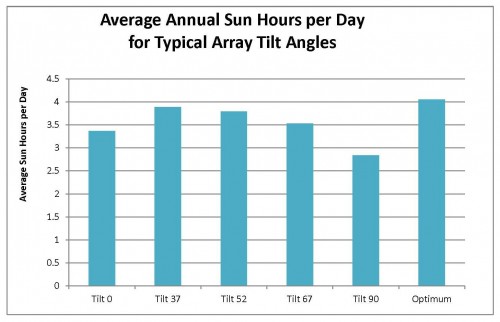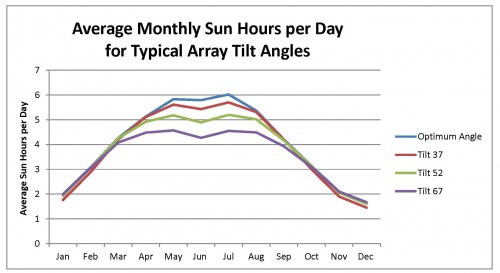What is the Best Tilt Angle for Your Solar Array?
- as close as possible to true south (not magnetic south)
- towards an area where nothing will shade it
- perpendicular to the sun's rays.
Tilting Your Array for Seasonal Changes

Unless you live near the equator, the sun's position above the horizon will change from summer to winter. In the summer, when your part of the world is tilted towards the sun, you will see the sun rise in the northeast, then move high up across the southern part of the sky to set again in the northwest. Come wintertime, the sun rises in the southeast and barely seems to get above the southern horizon before it sets again - all too soon - in the southwest. The further north you are, the greater is the difference between the winter and summer sun paths. What is the best fixed angle for these seasonal variations? Let's take a look at an example home site in central Saskatchewan at latitude 52 degrees north. There is plenty of climate data available that will show you how much sunshine you will get at a particular latitude and solar panel tilt angle.

Looking at the bar graph of average annual sunshine hours for various tilt angles, you can see that a good compromise is to tilt your array somewhere between 37 and 60 degrees. These angles receive almost as much sunshine as changing your array every month to set it for the optimum angle for that time of year. Another interesting graph of sunshine hours over the course of the year for several different tilt angles shows that the biggest difference is in the summer.

During the dead of winter, there is very little difference between the various angles. This means that if you are on a net metering system where you can store your excess energy from the summer for use in the winter you are better off with a lower angle that gives you better yearly production. So the bottom line is that there is not a huge difference in production between angles from 35 to 65 degrees. This means that if you have an unshaded south facing roof space at an angle somewhere in this range, a roof mounted array is the most cost effective choice for you.
Solar Array Angle for the Sun's Daily Path
The sun's path across the sky during the course of the day presents a much bigger challenge for keeping your panels pointed directly at the sun. Having ruled out a tracker for most applications, what's the best way to set up your fixed array?

Daily Solar Power
The sun is at its brightest at noon and at due south. If you face your array to the south you will capture the noon sun and also a large proportion of the morning and afternoon sun. If your array is facing more to the east you will lose some of the key noon hour advantage and some of the afternoon sun. Similarly, pointing the array more to the west will lose some of the morning sun and some of the noon hour production maximum.
Homes with roofs facing east-west are still good choices for roof mounted arrays if enough south facing roof space is not available. If you have a standard 4/12 roof pitch your panels will be angled at about 20 degrees and will still capture much of the solar production throughout the day. An east or west facing array at this angle will still produce about 80% of the production of an array on a south facing roof at the same tilt angle. Steeper east or west facing roofs will lose a little more of the production. Now you can have a look at solar mounting options to see which one will give you the best angle on your property.